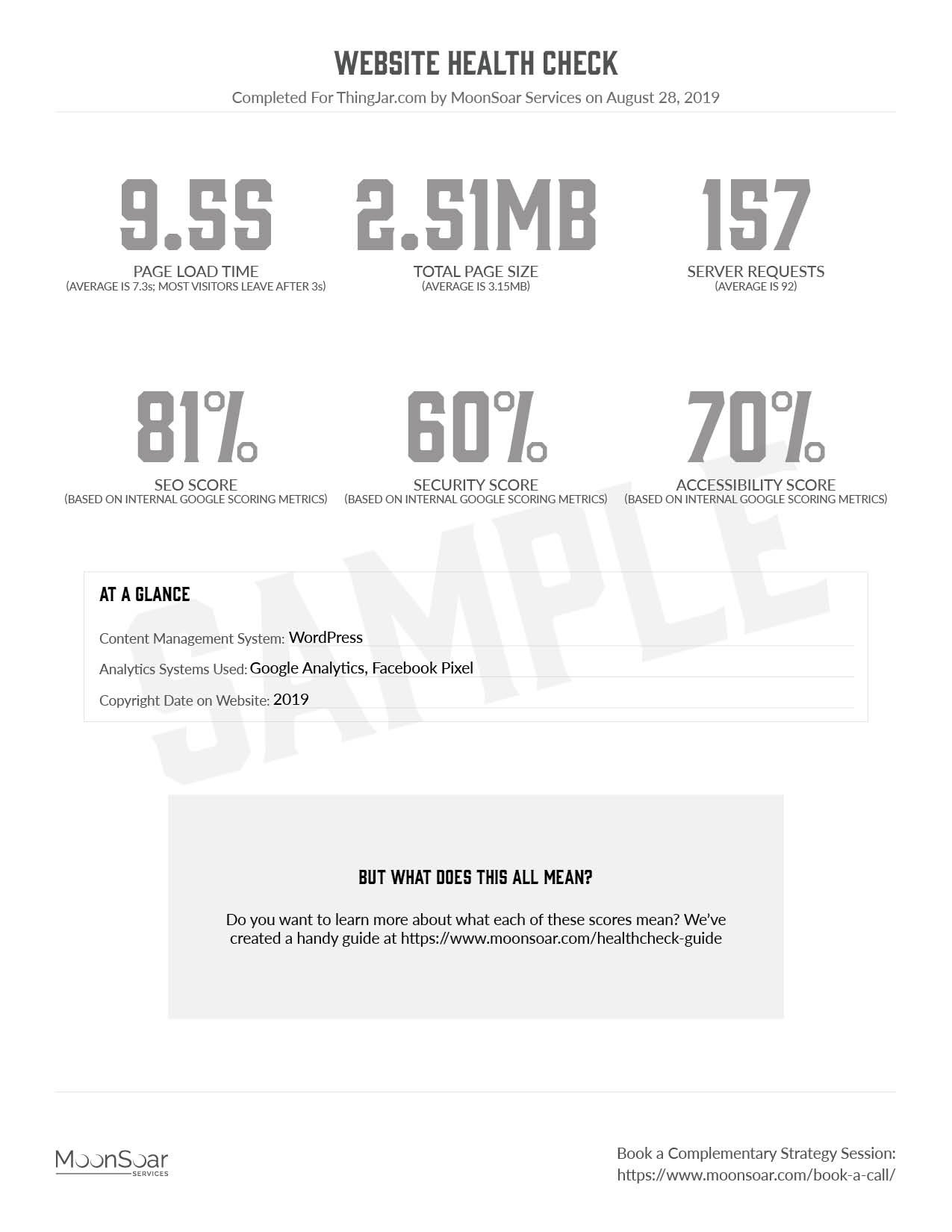The Website Health Check
How to Read This Report
Table of Contents (Jump To Section)
Introduction
Find out the health of your website. Receive a detailed report including the speed performance of your site, it’s SEO score and how it looks across a variety of mobile devices and desktop browsers. This website health check will provide actionable information and will help you understand what improvements you can make to bring more visitors to your site and keep them there.
Speed and Size Metrics
At the top of the report, you will find the performance of your page load time, and key metrics which contribute to this number. On the top half, lower numbers are better. A fast page load time is critical to retaining visitors. If they have to wait more than a couple of seconds, they may deem the page “taking too long to load” and bounce (a term meaning people who arrive at your site/page but quickly leave before doing or reading any of the things you wanted to bring them there for). Total page size is a good indication of how long it will take someone to download your web page to their browser. Not only can this impact how quickly the page loads, but people who have data caps may be unwilling to use up a large amount of their data plan on a web page. Server requests help understand how much communication is required between a browser and the server. If this number gets too high, it’s a good indication of why your page may be loading slowly. In the web browser has to ask the web host too many things, it can result in slower load times as the browser is trying to communicate with the host on what to display for a longer period of time.
Search, Security & Accessibility Scores
The next section shows three scores as percentages. These scores are for the areas of SEO , security score and accessibility. We wont tell you that everything needs to be 100%, as there’s a balance to be achieved, and even the most successful websites sites like youtube.com, amazon.com and facebook.com don’t score 100% across all metrics, but they all perform well in each metric.
SEO
SEO stands for search engine optimization – how well your page is optimized to rank highly in search results. In our case we benchmark against Google search. This makes sense because they dominate the search results market, and other search engines use similar criteria. The score is based on actual Google results, from Google itself when we test your page using their developer diagnostics. The criteria are a blend of best practices which allows Google to interpret your website properly, the quality of your content, the performance of your site and the inbound and outbound links demonstrating authority of your site and content.
Security
Security is important to both the peace of mind of the user and the SEO score as described above. We factor in if you are using a security certificate, are using code that has no known security vulnerabilities, are using an up to date content management system and have no links out to sites that are deemed unsafe. Just beneath the surface of our beloved world wide web is a constant tug of war between groups trying to create safe and secure website tools, and those trying to find vulnerabilities for either fun, for profit or even to help find things before they can be exploited. Website security is like good hygiene, and an ounce of prevention is worth a pound of cure.
Accessibility
Accessibility is important for several reasons. At the very surface, as you’ve probably already guessed, it factors into SEO scoring. Everything else being equal, Google prefers sites to be accessible. From a practical standpoint, the more accessible your website, the larger it’s potential reach. Accessable means content can be viewed on multiple browsers, and multiple devices (tablets, phones, desktop computers and laptops of varying screen sizes being the most common ones). Accessible also means steps can be made to improve the experience for those with visual impairments, those who may require screen readers, accessible for those who require high contrast, accessible for those who may have difficulty following fast slide shows or need accommodation due to cognitive differences. The internet is available to nearly everyone; just like the population at large that includes people with different needs who access the internet in different ways. There are best practices set out by the World Wide Web Consortium (W3C) known as the web content accessibility guidelines (WCAG). This is a very deep and broad topic, and we’re always happy to discuss the subject in more detail as it is a topic MoonSoar Services is passionate about.
Website Appearance on Multiple Device Types and Browsers
It’s easy to think because your website looks good on your computer and your phone that it displays as intended and is usable. Most people check to see if their own website is working on the computer and phone they use on a daily basis. This is a smart way to make sure nothing is terribly broken, but it ignores the fact there are several popular browsers, and countless phones which are widely used. A person using the latest iPhone and MacBook running Safari may view a website differently than a Windows desktop running Chrome and using Android device which is a few years old.
We help take the guess work out of how well a site displays by viewing your specified web page in several browsers on several devices. This is commonly called cross browser testing and cross device testing. Without a quality assurance team and a testing lab with many devices, this has always been a challenge. With our test, you will be able to see what your website looks like on a cross section of devices that cover the majority of the computer, mobile and browser landscape.





